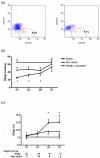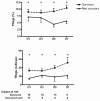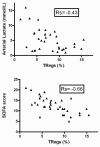The relationship between CD4+CD25+CD127- regulatory T cells and inflammatory response and outcome during shock states
- PMID: 20156359
- PMCID: PMC2875534
- DOI: 10.1186/cc8876
The relationship between CD4+CD25+CD127- regulatory T cells and inflammatory response and outcome during shock states
Abstract
Introduction: Although regulatory T lymphocytes (Tregs) have a pivotal role in preventing autoimmune diseases and limiting chronic inflammatory conditions, they may also block beneficial immune responses by preventing sterilizing immunity to certain pathogens.
Methods: To determine whether naturally occurring Treg cells have a role in inflammatory response and outcome during shock state we conducted an observational study in two adult ICUs from a university hospital. Within 12 hours of admission, peripheral whole blood was collected for the measurement of cytokines and determination of lymphocyte count. Sampling was repeated at day three, five and seven. Furthermore, an experimental septic shock was induced in adult Balb/c mice through caecal ligation and puncture.
Results: Forty-three patients suffering from shock (26 septic, 17 non septic), and 7 healthy volunteers were included. The percentage of Tregs increased as early as 3 days after the onset of shock, while their absolute number remained lower than in healthy volunteers. A similar pattern of Tregs kinetics was found in infected and non infected patients. Though there was an inverse correlation between severity scores and Tregs percentage, the time course of Tregs was similar between survivors and non survivors. No relation between Tregs and cytokine concentration was found. In septic mice, although there was a rapid increase in Treg cells subset among splenocytes, antibody-induced depletion of Tregs before the onset of sepsis did not alter survival.
Conclusions: These data argue against a determinant role of Tregs in inflammatory response and outcome during shock states.
Figures







Comment in
-
The kinetics of T regulatory cells in shock: beyond sepsis.Crit Care. 2010;14(2):132. doi: 10.1186/cc8897. Epub 2010 Mar 19. Crit Care. 2010. PMID: 20346091 Free PMC article.
Similar articles
-
Increased circulating regulatory T cells (CD4(+)CD25 (+)CD127 (-)) contribute to lymphocyte anergy in septic shock patients.Intensive Care Med. 2009 Apr;35(4):678-86. doi: 10.1007/s00134-008-1337-8. Epub 2008 Oct 23. Intensive Care Med. 2009. PMID: 18946659 Free PMC article.
-
Imbalance between Subpopulations of Regulatory T Cells in Patients with Acute Exacerbation of COPD.COPD. 2017 Dec;14(6):618-625. doi: 10.1080/15412555.2017.1385055. Epub 2017 Nov 22. COPD. 2017. PMID: 29166179
-
Removal of increased circulating CD4+CD25+Foxp3+ regulatory T cells in patients with septic shock using hemoperfusion with polymyxin B-immobilized fibers.Surgery. 2013 Feb;153(2):262-71. doi: 10.1016/j.surg.2012.06.023. Epub 2012 Aug 9. Surgery. 2013. PMID: 22884251
-
IL-10-producing and naturally occurring CD4+ Tregs: limiting collateral damage.J Clin Invest. 2004 Nov;114(10):1372-8. doi: 10.1172/JCI23215. J Clin Invest. 2004. PMID: 15545984 Free PMC article. Review.
-
The role of regulatory T cells in the pathogenesis of sepsis and its clinical implication.J Interferon Cytokine Res. 2012 Aug;32(8):341-9. doi: 10.1089/jir.2011.0080. Epub 2012 Jul 16. J Interferon Cytokine Res. 2012. PMID: 22799563 Free PMC article. Review.
Cited by
-
Regulatory T Cells Modulate CD4 Proliferation after Severe Trauma via IL-10.J Clin Med. 2020 Apr 8;9(4):1052. doi: 10.3390/jcm9041052. J Clin Med. 2020. PMID: 32276346 Free PMC article.
-
CD19+CD24hiCD38hi regulatory B cells deficiency revealed severity and poor prognosis in patients with sepsis.BMC Immunol. 2022 Nov 10;23(1):54. doi: 10.1186/s12865-022-00528-x. BMC Immunol. 2022. PMID: 36357845 Free PMC article.
-
Sepsis-Pathophysiology and Therapeutic Concepts.Front Med (Lausanne). 2021 May 14;8:628302. doi: 10.3389/fmed.2021.628302. eCollection 2021. Front Med (Lausanne). 2021. PMID: 34055825 Free PMC article. Review.
-
Temporal changes in regulatory T cell subsets defined by the transcription factor Helios in stroke and their potential role in stroke-associated infection: a prospective case-control study.J Neuroinflammation. 2023 Nov 23;20(1):275. doi: 10.1186/s12974-023-02957-w. J Neuroinflammation. 2023. PMID: 37996909 Free PMC article.
-
The kinetics of T regulatory cells in shock: beyond sepsis.Crit Care. 2010;14(2):132. doi: 10.1186/cc8897. Epub 2010 Mar 19. Crit Care. 2010. PMID: 20346091 Free PMC article.
References
Publication types
MeSH terms
Substances
LinkOut - more resources
Full Text Sources
Research Materials

